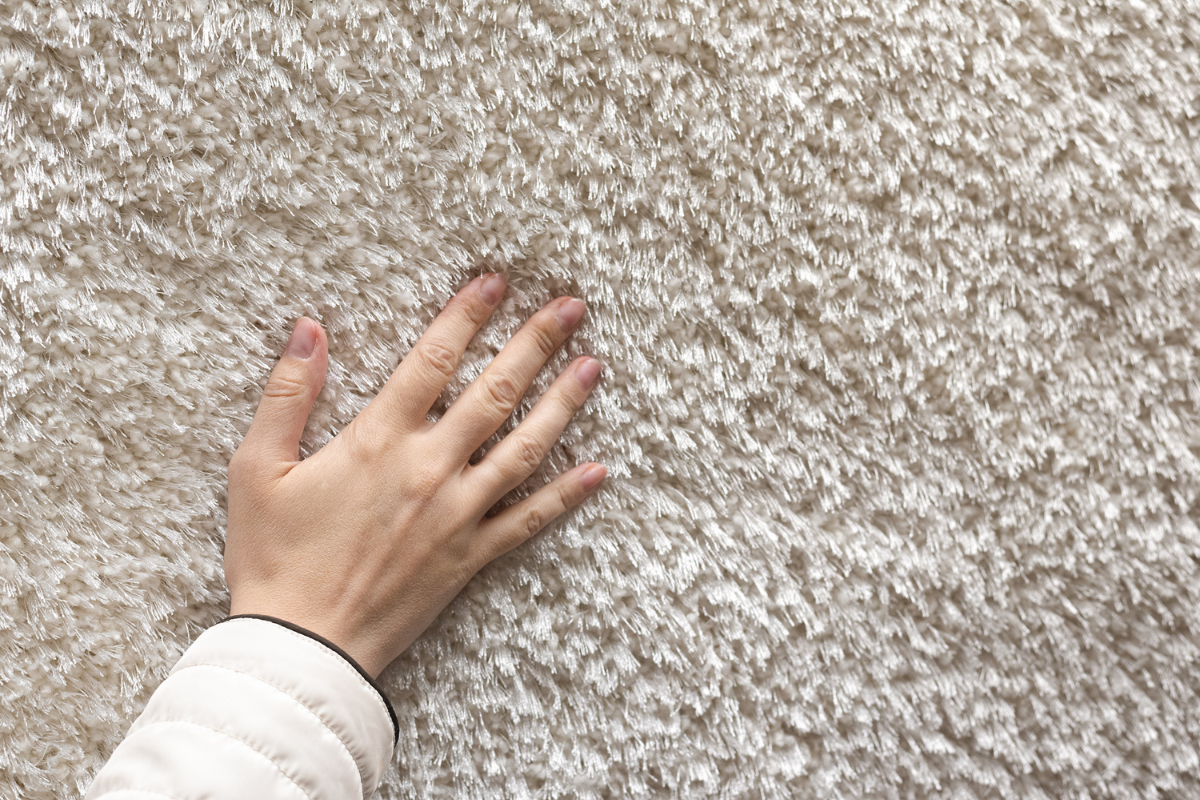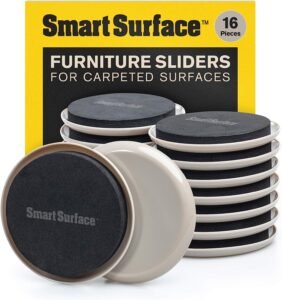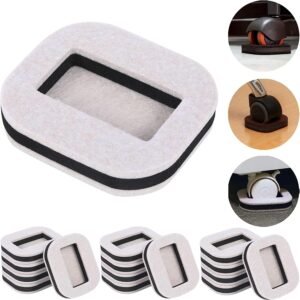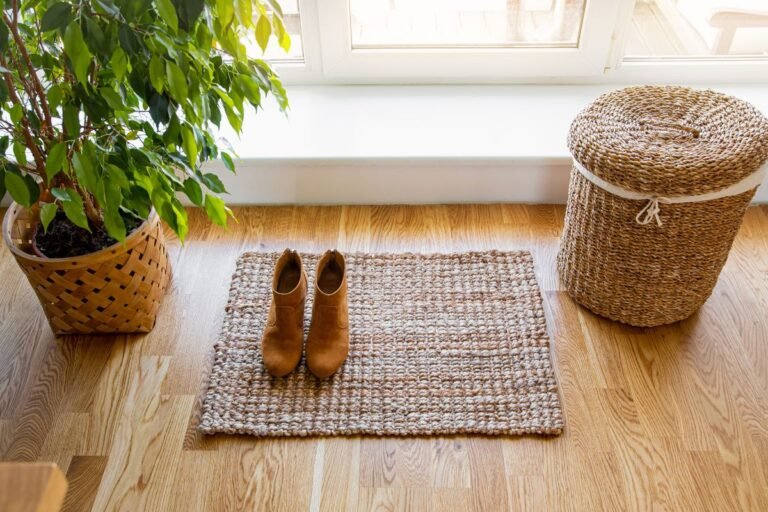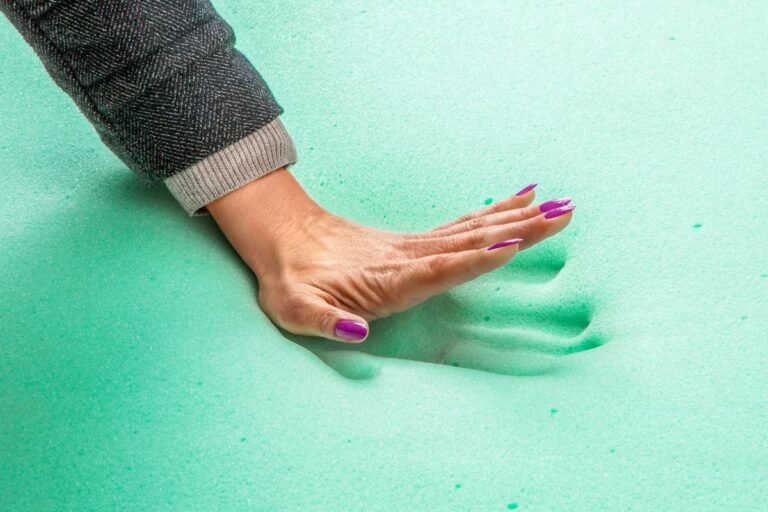Want to protect carpet from furniture? Well, there’s good news: there is such a thing as furniture floor protectors.
I’ll go through all of them now so that you can find the best option for your home.
Then, I’ll go into more detail about how furniture feet can impact the carpet surface and how this impacts which furniture floor protectors you’ll choose.
The Importance of Carpet Protectors for Furniture
Want to keep your carpets looking fresh and vibrant? Carpet protectors for furniture are your secret weapon. These handy tools are a must-have for any carpet owner, and here’s why.
It acts as a shield, stopping your heavy furniture from pressing too hard on your carpet. This even spread of weight stops furniture legs from creating those unsightly dents or even scratches without damaging the carpet fibers.
Carpet protectors protect against accidental damage. Without a protector, moving furniture could tear your carpet or pull out its fibers. But with a protector, your furniture slides smoothly, reducing the risk of damage.
Carpet protectors also help keep your carpet’s color from fading. Carpets in busy areas of your home can show signs of wear and tear, and furniture pressure can speed up this process. Using carpet protectors, you can slow down this wear and tear, keeping your carpet’s color and texture looking like new for longer.
Cleaning is also a breeze with carpet protectors. They stop dirt and dust from hiding under your furniture, making it easier to give your carpet a thorough clean. This not only helps your carpet last longer but also contributes to a healthier home environment.
In short, carpet protectors for furniture are a small investment with big returns. They’re easy to use, budget-friendly, and offer a practical solution to common carpet problems.
BOTTOM LINE: If you want your carpets to stay in top shape for years to come, carpet floor protectors will help you do that.
Different Types of Furniture Floor Protectors
Here are the basic options available to you:
Furniture Coasters for Carpets
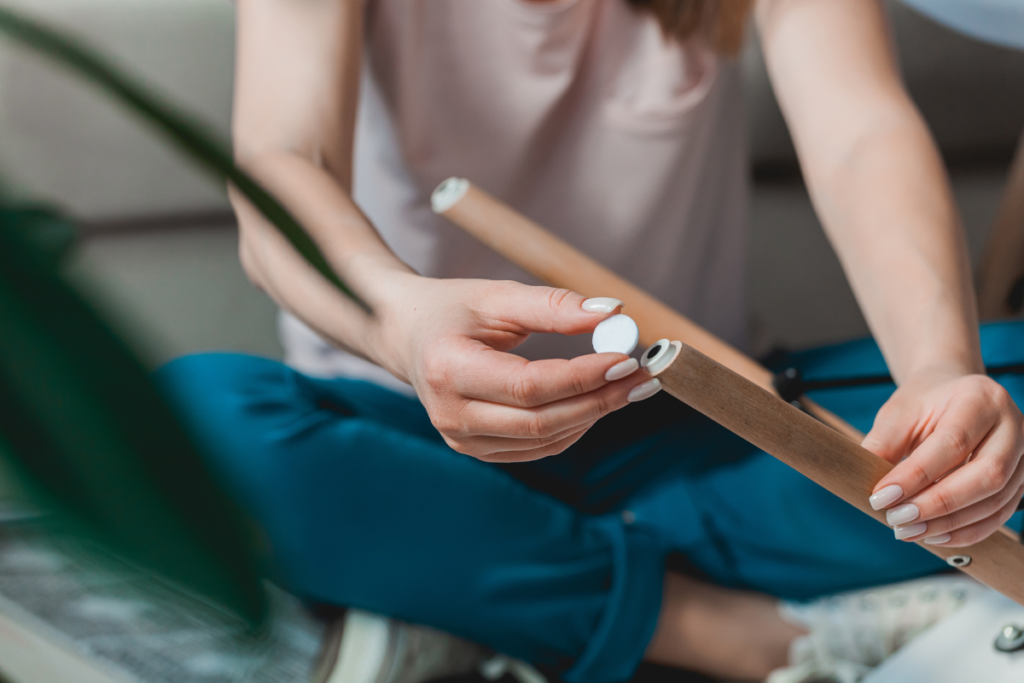
Furniture coasters, often referred to as furniture leg pads, are small, flat pieces of material designed to distribute the weight of your furniture evenly. They are typically placed under the legs of heavy furniture items like sofas, tables, and chairs.
By doing this, they prevent the furniture legs from digging into the carpet, causing unsightly indentations and potential damage to the carpet fibers. Furniture coasters come in a variety of materials, including rubber, plastic, and metal, and can be an effective and affordable solution for carpet protection.
Caster Caps for Carpets
Caster caps are a specific type of carpet protector designed for furniture with wheels, such as office chairs or rolling carts. These caps fit over the furniture’s casters, preventing them from directly contacting the carpet.
This is particularly useful for preventing damage caused by the constant rolling and turning of these types of furniture, which can quickly wear down carpet fibers. Caster caps are typically made of durable materials like plastic, rubber, or felt ensuring they can withstand the movement and weight of the furniture.
Rug Pads and Rug Over Carpet
Rug pads are another excellent tool for carpet protection, especially when you’re placing a rug over your carpet. These pads are designed to provide a barrier between the rug and the carpet, preventing unwanted movement and bunching that can lead to premature wear and tear.
Rug pads come in various materials, including rubber, memory foam, and felt pads, each offering different benefits. Felt rug pads, for instance, are great for providing extra cushioning and comfort, while rubber rug pads excel in preventing slippage. Memory foam pads reduce noise and provide extreme comfort 🤤
Not sure which rug pad to get?
Take the quiz to get started!
We recommend:
When placing a rug over carpet, choose a rug pad that’s specifically designed for this purpose. These rug pads are typically thinner and denser, preventing the rug from sinking into the carpet and ensuring it stays flat and smooth.
IMPORTANT: Whichever rug pad you choose, you will want the rubber side facing up and the softer side (like felt) facing the carpet.
When choosing a rug pad size, you’ll want to first measure your area rug. Then subtract 1″ from each side for thinner rug pads and 2″ from each side for thicker rug pads.
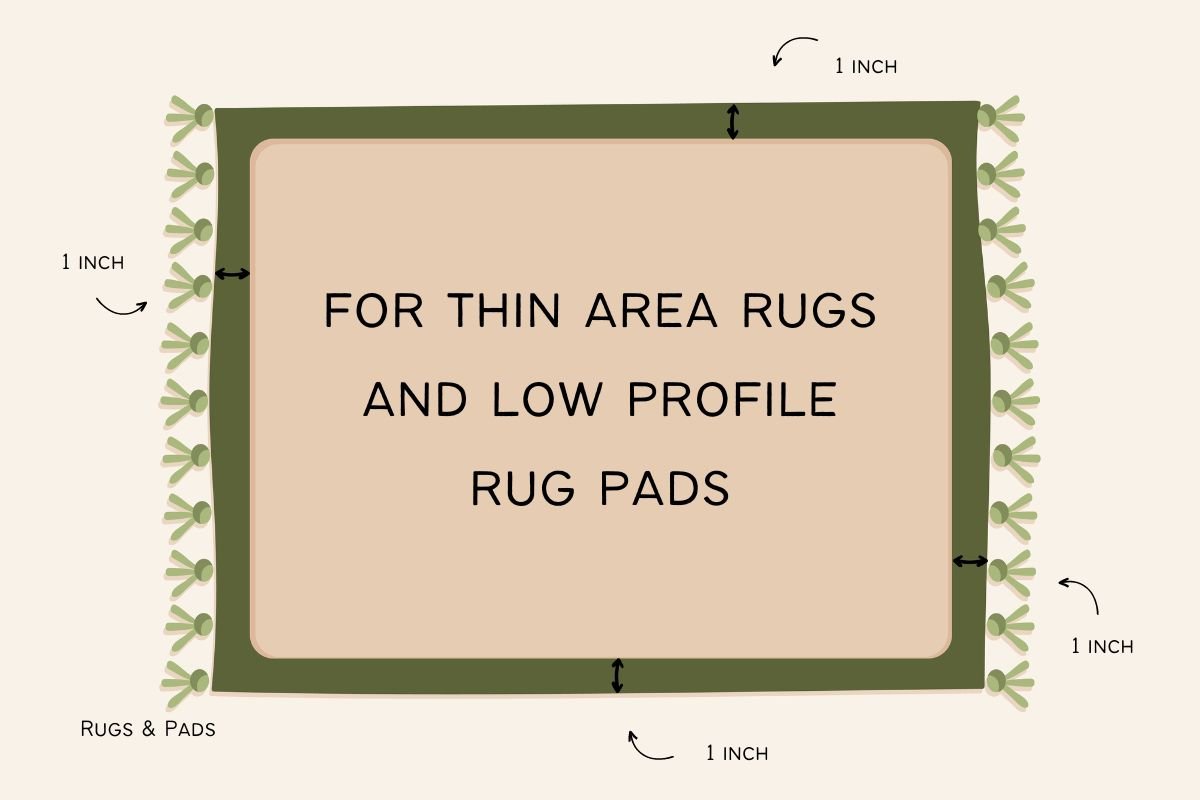
Understanding the Damage Furniture Can Cause to Carpets
When it comes to maintaining the beauty and longevity of your carpets, one often overlooked aspect is the potential damage that can be caused by furniture. It’s not just about the occasional spills and stains, but the physical impact that furniture can have on your carpets over time.
Let’s take a look at all the fun types of damage that furniture can inflict on your carpets.
Dents and Divots
The most common type of damage that furniture can cause to carpets is dents, also known as divots. These are depressions left in the carpet pile where the weight of the furniture has compressed the fibers. Over time, these dents can become permanent, especially with heavy furniture and high-pile carpets.
But don’t worry, there’s a solution to prevent this issue:
- Furniture Coasters: To protect your carpet from the dreaded dents and divots, we recommend using furniture coasters.
- Rug Pads: These pads not only provide an extra layer of cushioning but also help prevent dents by reducing the impact of heavy furniture on your carpet.
Wear and Tear
Another type of damage is the wear and tear caused by moving furniture. Dragging a piece of furniture across the surface of the carpet can cause the fibers to fray or even tear, especially if the furniture has sharp edges or rough feet. This type of damage can be quite noticeable and can detract from the overall appearance of your carpet.
Here are some possible solutions:
- SuperSliders Self-Stick Furniture Sliders: These sliders are easy to install and provide a smooth surface that glides over your carpet, preventing fraying or tearing caused by moving and sliding furniture.
- X-Protector Non Slip Furniture Pads: These pads offer strong adhesive that ensures they stay on your furniture feet, preventing any potential carpet damage from dragging or moving furniture.
- SoftTouch Self-Stick Non-Slip Surface Grip Pads: These pads not only prevent furniture movement but also provide a soft cushioning to prevent any sharp edges or rough feet from damaging your carpet.
Color Fading
Furniture can also cause color fading in carpets. This is particularly true for furniture that is frequently exposed to sunlight. The UV rays can cause the color of the carpet under the furniture to fade, leading to uneven coloration when the furniture is moved.
But don’t worry, there are several effective solutions to this issue:
- Use Furniture Coasters: Furniture coasters are not just for hardwood floors. They can also protect your carpets from color fading. By distributing the weight of the furniture over a larger area, they reduce the pressure on any one spot of your carpet, thus preventing color fading.
- Rotate Your Furniture: Regularly changing the position of your furniture can prevent color fading. By doing this, you ensure that the same area of your carpet isn’t always exposed to sunlight or under the pressure of heavy furniture.
- Use Window Treatments: UV rays from the sun are a major cause of color fading. Using window treatments like curtains, blinds, or UV window film can significantly reduce the amount of sunlight that reaches your carpet, thus preserving its color.
- Regular Cleaning: Regularly cleaning your carpet can also help maintain its color. Dirt and dust can cause the carpet fibers to become matted, which can make the color appear faded. Regular vacuuming and professional cleaning can keep your carpet looking vibrant.
Mold and Mildew
Lastly, furniture can contribute to the growth of mold and mildew in carpets and floors. This is because furniture can trap moisture, creating a damp environment that is ideal for mold and mildew growth. This is particularly a problem in areas with high humidity or in cases of water spills that are not properly dried.
- Regular Cleaning and Vacuuming: Regular cleaning is the first line of defense against mold and mildew. Vacuum your carpet regularly to remove any dirt or moisture that may have accumulated. If your furniture is heavy, consider getting help to move it so you can clean underneath.
- Use of Dehumidifiers: In areas with high humidity, a dehumidifier can be a lifesaver. It reduces the moisture level in the air, making it harder for mold and mildew to grow. Place a dehumidifier in the room and let it work its magic.
- Furniture Coasters: Furniture coasters aren’t just for preventing scratches on your floors. They can also improve air circulation under your furniture, preventing the buildup of moisture. Choose coasters that are suitable for your carpet and furniture type.
- Carpet Cleaning Products: There are numerous carpet cleaning products on the market that can help prevent mold and mildew growth. Look for ones that specifically target these issues. Remember to always test a small, hidden area first to ensure the product doesn’t discolor your carpet.
- 5. Professional Carpet Cleaning: Sometimes, the best solution is to call in the professionals. Professional carpet cleaners have the tools and expertise to deep clean your carpets and remove any lurking mold or mildew.
Understanding these potential damages is the first step towards protecting your carpets. In the following sections, I’ll provide you with practical tips and solutions to prevent these issues and keep your carpets looking their best.
How to Protect Carpet from Furniture

Heavy furniture can leave unsightly dents and marks on your carpet, but don’t worry, there are ways to prevent this. Here are some practical tips and steps to protect your carpets from heavy furniture:
- Use Furniture Coasters or Cups: These are small, often round, pieces of plastic or rubber that you place under the furniture legs. They distribute the weight of the furniture more evenly, preventing deep dents in your carpet.
- Opt for Furniture Pads: Furniture pads, also known as furniture sliders, are another great option. They not only protect your carpet from dents but also make it easier to move heavy furniture around without damaging the carpet.
- Rotate Your Furniture: Regularly changing the position of your furniture can prevent long-term damage to your carpet. This is because it prevents the weight of the furniture from being concentrated in one area for an extended period.
- Use Area Rugs or Mats: Placing an area rug or mat under your heavy furniture can protect your carpet. They take the brunt of the weight and can be easily replaced if damaged.
- Try a Sectional Sofa: Instead of one large sofa, consider a sectional sofa. This type of sofa has multiple pieces, which means the weight is distributed over a larger area.
- Regular Carpet Cleaning: Regularly clean your carpet to maintain its resilience. Dirt and dust can make your carpet fibers more susceptible to crushing, so regular vacuuming is essential.
- Invest in High-Quality Carpet: High-quality carpets are more resilient and better equipped to handle the weight of heavy furniture. They may be more expensive initially, but they can save you money in the long run.
Remember, the key to protecting your carpet from heavy furniture is to distribute the weight and reduce the pressure on the floor in any one spot. With these tips, you can keep your carpet looking fresh and dent-free!
Frequently Asked Questions
How Do I Protect My Carpet From Furniture Marks?
Protecting your carpet from furniture marks can be achieved in several ways. One of the most effective protection methods is using furniture coasters or cups. These are placed under the furniture legs to distribute the weight more evenly and prevent deep indentations. You can also use furniture pads, which are similar to coasters but are typically made of a soft material like felt. Regularly moving your furniture slightly can also help to prevent permanent marks.
How Do You Protect Carpet Under Heavy Furniture?
Heavy furniture can cause significant damage to your carpet if not properly managed. One of the best ways to protect your carpet is by using high-quality furniture pads or sliders. These products are designed to distribute the weight of your furniture more evenly, reducing the pressure on your carpet. For extremely heavy items, consider using a thick plastic mat to provide an extra layer of protection.
What Can You Put Under Chair Legs To Protect Carpet?
There are several products you can put under chair legs to protect your carpet. Furniture pads, often made of felt or rubber, are a popular choice. They’re easy to install and can help to reduce the impact of the chair legs on your carpet. Another option is furniture cups or coasters, which are typically made of plastic or rubber. These products can help to protect carpet from furniture feet and distribute the weight of the chair more evenly, reducing the risk of indentations.
Can You Put Something On Carpet To Protect It?
Yes, there are several products designed to protect carpets. Carpet protectors come in various forms, including plastic mats and runners. These products can be particularly useful in high-traffic areas or under rolling chairs. Additionally, using a high-quality carpet pad under your entire carpet can provide an extra layer of protection and extend the life of your carpet.
Tips for Maintaining Your Carpet
Carpets are a fantastic way to add warmth and style to any room. However, they require a certain level of care to keep them looking their best. Here are some practical tips to help you maintain your carpet and prevent damage:
- Regular Vacuuming: This is the most basic and essential step in carpet maintenance. Vacuum your carpet at least once a week to remove dust, dirt, and allergens. This not only keeps your carpet clean but also extends its lifespan.
- Prompt Stain Removal: Accidents happen, and when they do, it’s crucial to act quickly. Blot the stain immediately with a clean cloth to absorb as much of the spill as possible. Then, use a carpet cleaner suitable for your carpet type to remove the stain. Remember, scrubbing can damage the carpet fibers, so it’s better to blot.
- Use Carpet Protectors: Consider using furniture coasters or cups under the legs of heavy furniture to distribute the weight and prevent crushing the carpet fibers. You can also use area rugs or runners in high-traffic areas to minimize wear and tear.
- Professional Cleaning: Even with regular vacuuming and spot cleaning, your carpet can benefit from a professional deep cleaning every 12-18 months. This can help remove stubborn dirt and residue, and keep your carpet looking fresh and new.
- Rotate Furniture: Periodically moving your furniture around can change the traffic pattern in your room and allow the carpet to wear more evenly. This can help prevent certain areas from becoming worn out or faded.
- Avoid Direct Sunlight: Just like other fabrics, carpets can fade when exposed to direct sunlight for extended periods. Use blinds, shades, or curtains to protect your carpet from harsh sunlight.
Remember, a well-maintained carpet not only enhances the aesthetics of your room but also improves the air quality by trapping dust and allergens. So, invest some time in carpet care and enjoy the comfort, ease and beauty it brings to your space.
The Bottom Line
You’ll want to put something between your furniture feet and the floor. Now you need to determine which floor protector is right for you! I’ve given you all of the information you need to do that, so now it’s over to you 🙂

